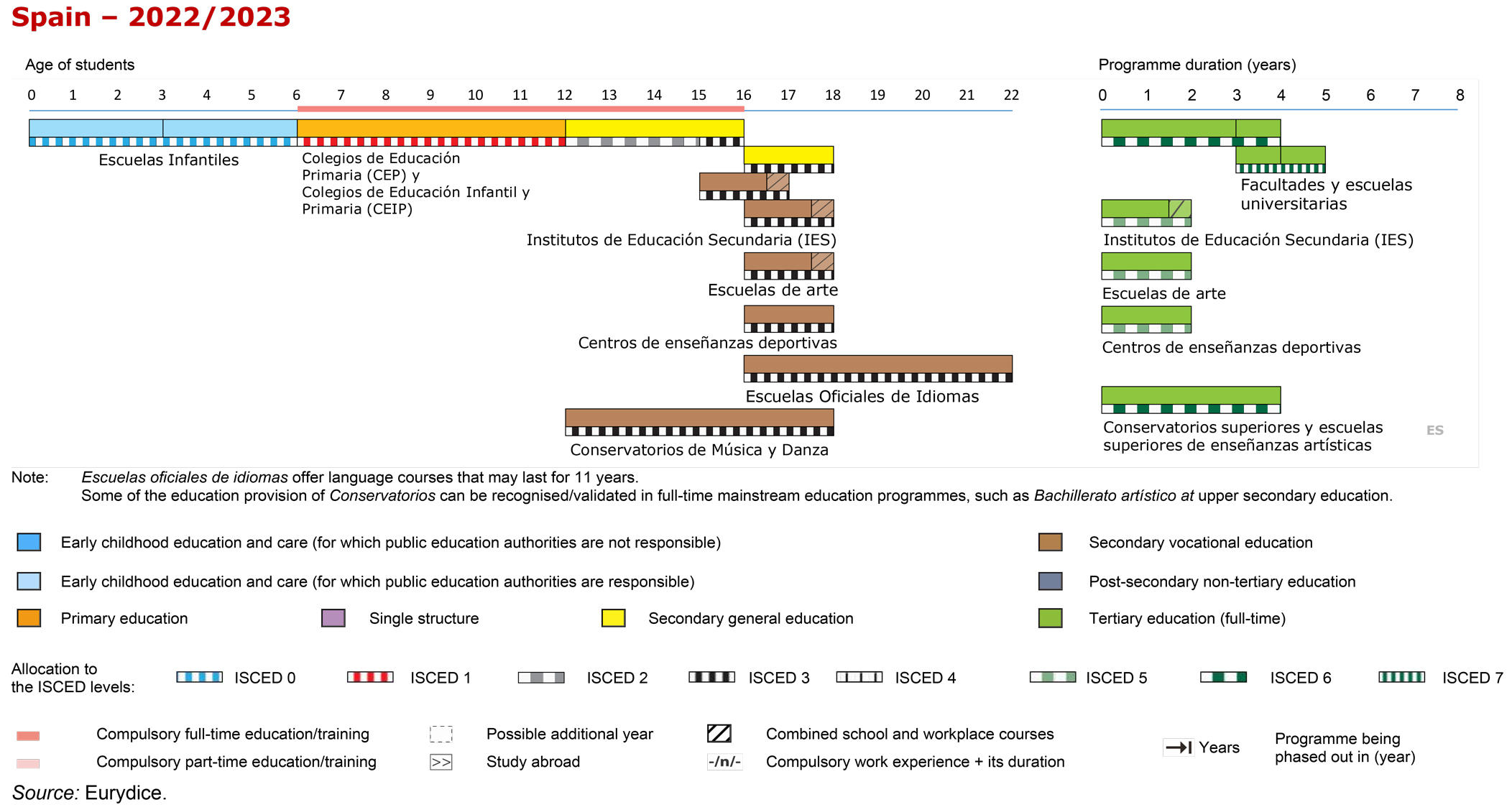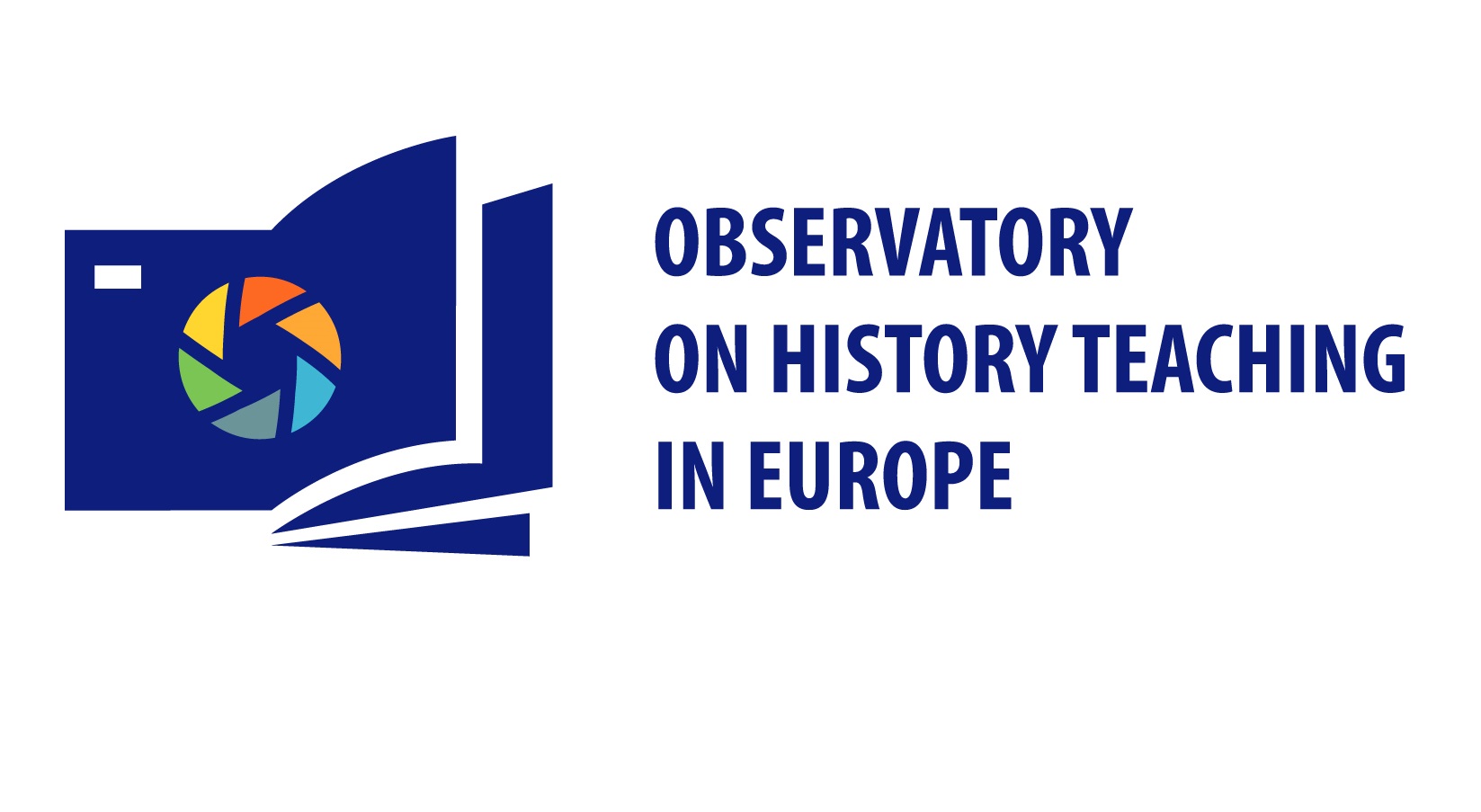Spain
STRUCTURE OF THE NATIONAL EDUCATION SYSTEM
 Source: Eurydice 2022/23
Source: Eurydice 2022/23
The authorities that determine and control school curricula in Spain are the Spanish Government, through the Ministry of Education and Vocational Training, and the regional education administration (departments of education) of each of the 17 autonomous communities. That means that the Spanish Government is responsible for the design and establishment of the basic aims, framework and content to be integrated into the curriculum (Real Decreto). Once this general guideline is approved, the departments of education of each autonomous community define the final curriculum aspects for their respective territory (area of competence) (Decretos or Órdenes). The resultant 17 regional curricula can be defined as state-prescribed, as the state establishes the principles and contents meant to be taught in the schools of each territory.
Schools have flexibility in the way they organise the learning process within the framework established by regional authorities. Private schools must respect the national curricula framework. Only international schools are considered independent schools, and are linked to the curricula and education organisation of their own countries. The Spanish pre-university educational system is divided into three stages: early childhood education (ages 0-5); primary education (ages 6-11); and secondary education (ages 12-16). Schooling in Spain is compulsory between the ages of 6 and 16. Once compulsory education is completed, students can continue their training via two post-compulsory secondary education pathways: baccalaureate (Bachillerato) and Intermediate Vocational Education and Training (ages 16-18).*
For more information on the national education system in Spain, please visit:
Ministry of Education and Vocational Training
*OHTE Thematic report on "Pandemics and natural disasters as reflected in history teaching"
HISTORY IN SCHOOL
Data are currently being collected for the OHTE general report.
This section will host information on the space and time provided to ‘History’ as a subject matter within the three main levels of education (primary, lower secondary and upper secondary). It will also provide insights on the relationship between history and other school subjects.
HISTORY CURRICULUM
Data are currently being collected for the OHTE general report.
Within the framework of the legislative texts, there is flexibility in the way schools and teachers develop the basic contents. The supervision of textbooks and other curricular materials is the responsibility of the regional educational administrations as a part of the ordinary inspection process carried out on all the elements related to the teaching and learning process, which must ensure that the constitutional principles and values, as well as the provisions of organic law are respected. The regional administrations are also competent to establish the methodological guidelines and evaluate. There is also space for teachers to deal with certain examples in more depth, take different approaches and so on. However, there has been a transition from LOMCE curricula based on learning standards (in force 2015-22), which left little room for the independence of teachers, to guidelines for the new orientation curricula that allow teachers a more flexible approach (LOMLOE, in force since January 2021). While the former LOMCE curricula were still rather linked to the encyclopedic mode (De Ketele 2008; López-Goñi and Goñi 2015), the LOMLOE calls for a deeper competence-based focus of the curricula. At the moment, schools are undergoing a process of adaptation to this new educational law.38 In 2022-23, new curricula have been implemented in alternate grades of the different levels of education, that is, 1st, 3rd and 5th grades in primary education; 1st and 3rd in compulsory secondary education and 1st in Bachillerato. New curricula will be fully implemented by 2023-24.
Although LOMLOE proposes a new competence-oriented curricula, both LOMCE and LOMLOE follow a similar structure. In primary education the new curriculum (LOMLOE, Real Decreto 157/2022) includes history within a subject called “Knowledge of the natural, social and cultural environment”, which follows an interdisciplinary approach combining content from the natural and social sciences. In secondary education, history is taught in every year of compulsory secondary education, in a subject called “geography and history”. The new curricula have implied no changes in the organisation of the teaching of history in Bachillerato either: “History of the contemporary world” is one of the two specific subjects to be chosen by students in the first year of Bachillerato of Humanities and Social Sciences, while “History of Spain” remains a compulsory subject for every student in the second year of Bachillerato of all modalities (Arts, General, Humanities and Social Sciences, and science and technology).*
Curricula workstation by GEI (History curricula search by country)
*OHTE Thematic report on "Pandemics and natural disasters as reflected in history teaching"
LEARNING OUTCOMES AND ASSESSMENT
Data are currently being collected for the OHTE general report.
This section will contain information on the learning outcomes set for history lessons within the different levels of education and on the methods of testing and assessment used in history examinations.
EDUCATIONAL RESOURCES AND PEDAGOGY USED IN THE HISTORY CLASSROOM
Data are currently being collected for the OHTE general report.
This section will host data on the study material and teaching practices used for history teaching within the different levels of education.
International TextbookCat (GEI collection of Textbooks and Educational Media)
HISTORY TEACHERS
Data are currently being collected for the OHTE general report.
This section will provide an overview of the number of history teachers within the different levels of education, as well as relevant information on teachers’ initial training and in-service training available to them.
Spanish Association of History and Geography Teachers (presentation by EuroClio)
Spanish Association of History and Geography Teachers (official website)
THEMATIC DATA
The Observatory on History Teaching in Europe also provides thematic studies on given topics.
2022: Pandemics and natural disasters as reflected in history teaching



